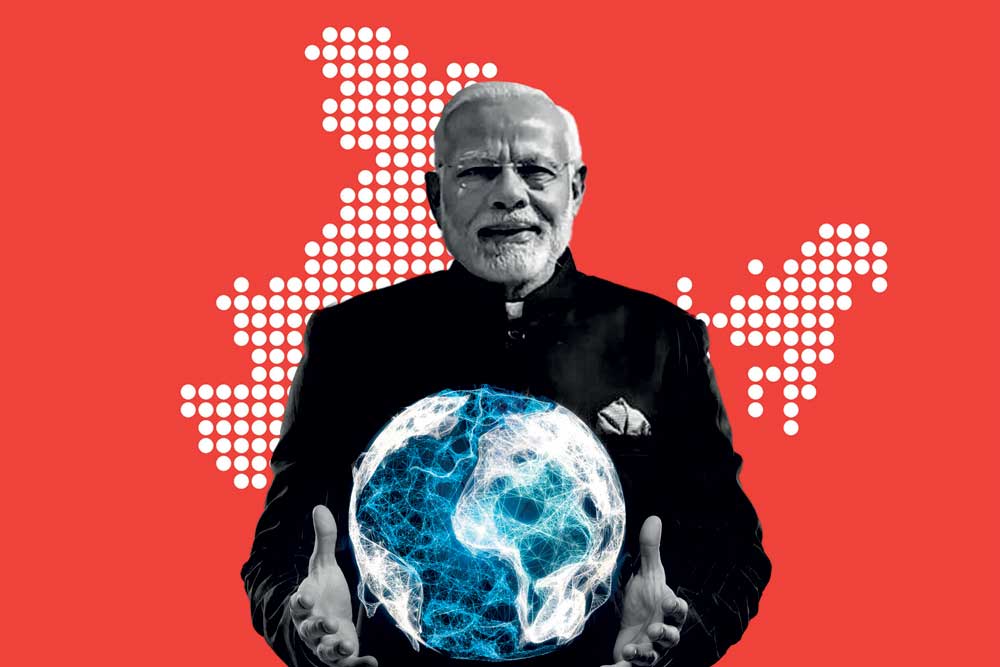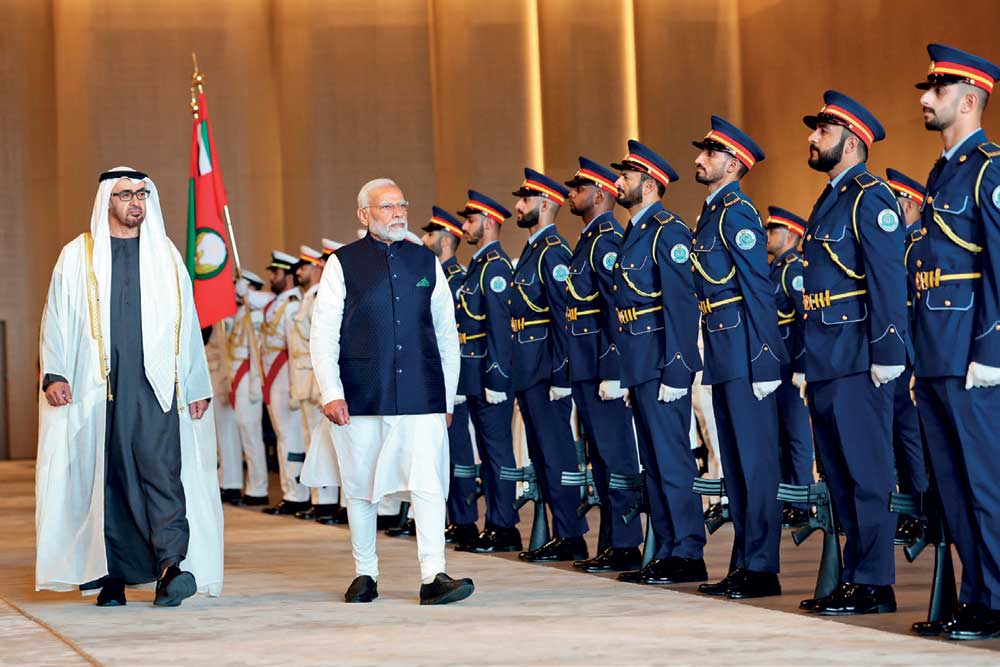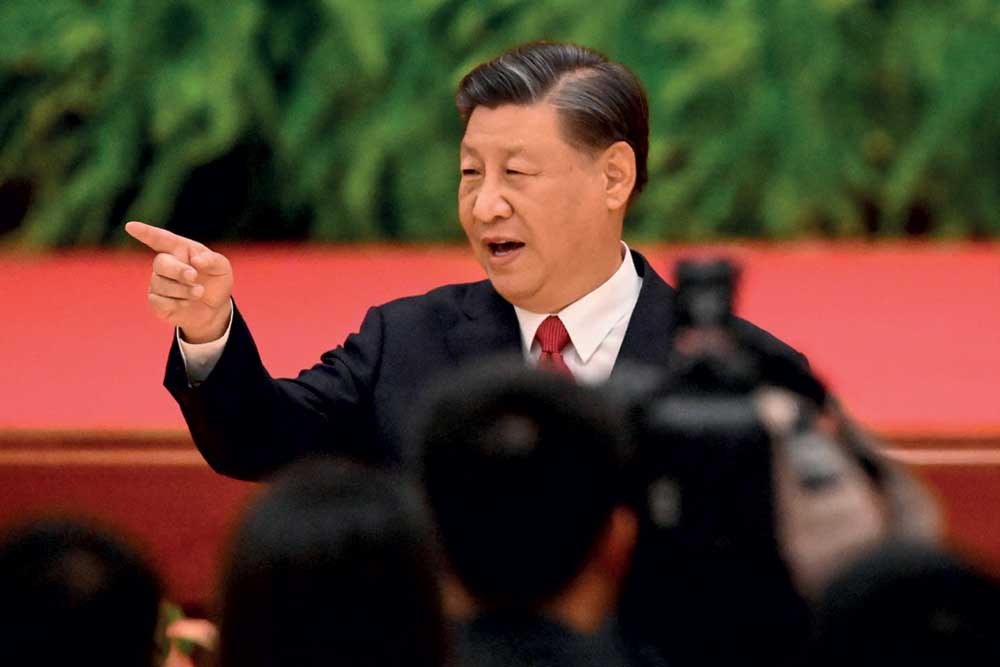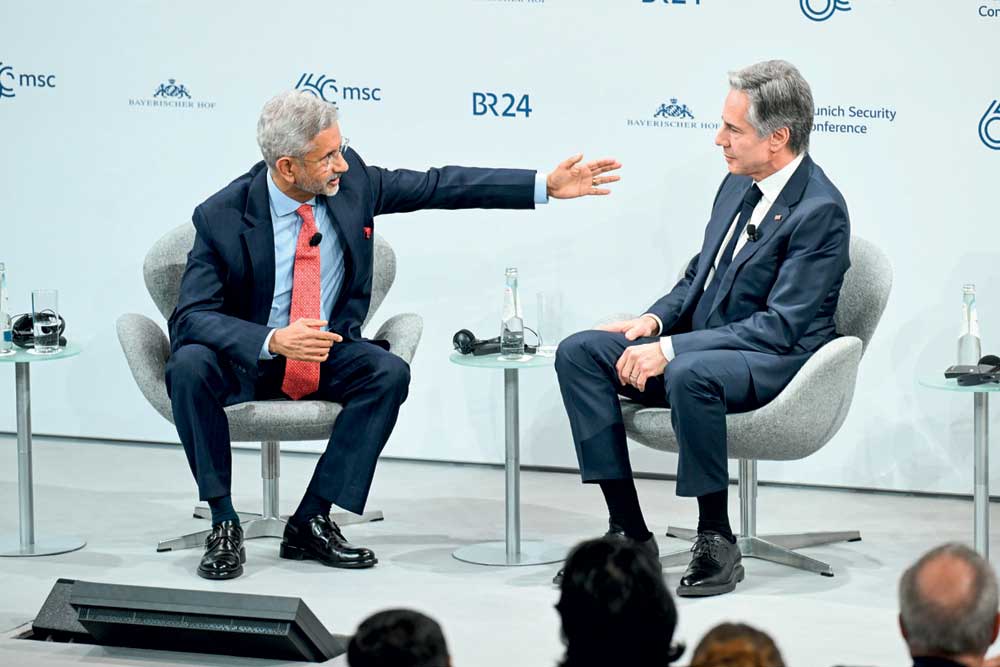India can be the bridge-builder in a divided world
Brahma Chellaney | OPEN magazine

Few would doubt that India’s international profile and geopolitical weight have been rising, making it a key ‘swing’ state in the current transition from the US-led, post-World War II order to a new global order. Despite growing international turbulence, as underlined by crises, conflicts, wars and new threats, Indian foreign policy displays dynamism and confidence.
This is apparent from the close strategic partnerships India has built or reinforced with rival major powers, including the US and Russia. In fact, India is being courted by all the great powers.
Because India confronts what might be called the “tyranny of geography” in its own region—that is, serious external threats from virtually all directions—it must pursue extra-regional options to advance its economic and security interests. India, the region’s geographical hub, may be the world’s largest democracy but authoritarian structures have not been fully dismantled in neighbouring countries.
An unstable neighbourhood, to be sure, heightens the danger of spill-over effects for India, which would threaten its internal security. For example, the ethnic violence in Manipur state has been accentuated by the illegal influx of thousands of ethnic Chin from violence-torn Myanmar, which risks turning into a failed state because of crippling US-led sanctions and escalating armed attacks by insurgents attempting to overthrow the military junta.
Against this backdrop, India has little choice but to reach out beyond its immediate neighbourhood to help surmount the “tyranny of geography”. This explains the priority it attaches to expanding diplomatic and economic relations with other regions.
In the Middle East, for example, India’s expanding footprint owes a lot to the close relations Prime Minister Narendra Modi has forged with Israel and important Arab states. Modi, although accused by his critics of promoting Hindu nationalism, has built a strong personal rapport with the rulers of the Persian Gulf sheikhdoms, which are the citadels of Wahhabi Islam, the source of modern Islamic fundamentalism.
Modi, who on his seventh visit to the United Arab Emirates (UAE) recently inaugurated the first stone-built Hindu temple in the entire Middle East, refers to the Emirati president, Sheikh Mohamed bin Zayed Al Nahyan, as his “brother”. The UAE, the most liberal and forward-looking of the Gulf states, has rapidly emerged as one of the largest investors in, and a close trade and security partner of, India.
India, the world’s third-biggest importer of oil, sources 65 per cent of its crude imports from the Gulf states, which are also supplying fast-increasing quantities of liquefied natural gas (LNG) to the country. The nearly 9 million Indian expats in the Gulf region, including the world’s largest Indian diaspora of 3.4 million in the UAE, account for about 30 per cent of the $90 billion global remittance flowing to India yearly. Known to be disciplined, dedicated, hard-working and peaceable, the Indian expats in the Middle East are one of India’s most distinct soft power assets.
With size comes geopolitical, economic and cultural power. And with power comes respect. With its cherished foreign-policy autonomy and willingness to break with conventional methods and shibboleths, India is well placed to serve as a go-between in the Ukraine war and as a mediator in the Israeli-Palestinian conflict
Consider another region, East Asia, where India has bolstered trade and strategic ties with historic rivals Japan and South Korea. India has virtual free trade agreements (FTA) with these two countries, which today are seeking to overcome the historical baggage that still weighs down their bilateral relationship. India-Japan military exercises now extend to all three domains—air, maritime and land—and cover strategic, operational and tactical levels.
The neighbourhood constraints make it imperative for India to build stronger ties not just with the other major powers but also with important countries located in different regions.
KEY FACTORS
Several factors are central to a country’s international position, including its political and economic trajectory. Without political stability at home, economic growth will likely suffer.
Despite the plethora of political parties in India that largely team up in coalitions, especially before elections, the country has been fortunate to have enjoyed political stability under three successive prime ministers—Atal Bihari Vajpayee, Manmohan Singh (more so in his first term than his scandals-filled second tenure), and Narendra Modi.
Contrast that with the unending political crisis in military-dominated, China-indebted Pakistan, with that nation now confronting the worst economic crisis in its history. Indeed, the phrase “international basket case” might better apply to Pakistan today than it did to Bangladesh in 1971 when it won independence despite the Pakistani military’s genocide, in which three million people were killed, 200,000 women were confined in rape camps, and 10 million more people were forced to flee to India.
Under Sheikh Hasina, who has led a secular government since 2009 that Bangladeshi Islamists detest, Bangladesh has had political stability and rapid economic growth. Bangladesh’s impressive-growth trajectory stands in stark contrast to the chronic political and economic turmoil in Pakistan, which is still teetering on the brink of default.
Against this background, India’s continued rise hinges on sustained political stability at home. A stable, forward-thinking government can frame and pursue long-term strategic goals, including further accelerating economic growth, advancing development of critical and emerging technologies (including semiconductors, which have grown into a key international geopolitical battleground), underpinning military prowess with an expanded weapons-manufacturing base at home, strengthening nuclear-weapon, missile and drone capabilities, and bolstering internal security and social cohesion.
The 1998 nuclear weapons’ tests proved to be a watershed moment for India, raising its international profile and setting in motion the process for the US to gradually lift most of its technology sanctions against New Delhi. For more than a quarter of a century, the US had kept the world’s largest democracy under sanctions, while it actively aided communist China’s rise and armed Pakistan against India. And, as the <New York Times> reported in 1998, the US and China covertly helped Pakistan to build its nuclear bomb.
It was fortunate for India’s security and upward trajectory that the nuclear weapons’ tests were carried out six weeks after Vajpayee took office. Had Vajpayee waited six months, there probably would have been no such tests, given how the heady allure of power and its corrupting effects can easily weaken political resolve.
The five underground nuclear tests in 1998 exposed the utter failure of US policy to keep India from going overtly nuclear by employing technology sanctions and diplomatic pressure. Predicting test yields accurately holds the key to manufacturing sophisticated nuclear weapons. And, as underscored by post-shot radiochemical analyses, the yields from the five tests were in line with what the Indian scientists had aimed for.
Left to lick its wounds, the US began quietly reversing its policy towards India through diplomatic outreach, including closed-door talks. In mid-1999, Bill Clinton became the first American president to openly side with India against Pakistan in wartime when he successfully pressured then-Pakistani Prime Minister Nawaz Sharif to pull back his forces from the areas that they had furtively encroached upon in Ladakh’s Kargil region. And about eight months later, Clinton heralded a new beginning in Washington’s relationship with New Delhi by paying a five-day visit to India, the first by a US president in almost a quarter-century.
Since then, America’s embrace of India has persisted (and strengthened) under four succeeding presidents—George W Bush, Barack Obama, Donald Trump, and Joe Biden.
India’s rapid economic growth, with the Indian economy now the fastest growing among major countries, has reinforced bipartisan support in Washington for a closer partnership with New Delhi. US exports to India have boomed. Indeed, the US has become an important source of even crude oil and petroleum products for India, which is the world’s third-largest oil consumer after America and China.

Meanwhile, the profound development that helped transform India’s global position—its going overtly nuclear—now figures little in the Indian or American discourse.
Yet India now faces an ongoing build-up of nuclear and missile forces in its neighbourhood, especially by China. The unprecedented speed and scale of the Chinese nuclear build-up appears to be linked to President Xi Jinping’s international expansionism as China seeks global primacy by 2049, the centenary of communist rule.
Modi refers to the Emirati President, Sheikh Mohamed bin Zayed Al Nahyan, as his ‘brother’. The UAE, the most liberal and forward-looking of the Gulf states, has rapidly emerged as one of the largest investors in, and a close trade and security partner of, India
The huge nuclear-weapons build-up is set to lengthen China’s shadow over Asia while heightening military tensions with its main Asian rivals—India and Japan. India, alas, has remained smugly content with the outcome of its 1998 tests, instead of seeking to enhance the credibility of its nuclear deterrent through a stockpile-stewardship programme that includes subcritical and other hydronuclear experiments. Today, India needs to pay close attention to Xi’s nuclear frenzy.
India’s global standing, in more recent years, has also benefited from two other factors, both China-related.
The first is the West’s belated recognition of Xi’s imperialist ambitions, which have spawned China’s aggressive expansionism almost since he came to power in 2012. Xi seems to believe that China has a narrow window of strategic opportunity to modify the international order in its favour before it confronts a deepening demographic crisis, stalled economic growth, and an unfavourable global environment. Accordingly, Xi has shown an increasing appetite for taking major risks.
President Biden, in his 48-page national security strategy released in October 2022, made clear that over the long term the US was more worried about China’s moves to “layer authoritarian governance with a revisionist foreign policy” than it was about a sanctions-battered Russia, whose strategic ambitions are regionally confined. China “is the only country with both the intent to reshape the international order and, increasingly, the economic, diplomatic, military and technological power to advance that objective,” the strategy report said.
It has become clear to many Americans that China is not a friend or a partner but rather an adversary bent on global dominance by supplanting the US. Multiple opinion surveys have shown that the number of Americans who view China as their country’s “greatest enemy” or “greatest threat” has more than doubled since 2020, increasing to over half of US adults. As an adversary in American eyes, Russia is now a distant second to China.
History will record 2020 as a watershed year for Beijing when international attitudes visibly changed and many economies learned hard lessons about China-dependent supply chains. The tide began to turn when the Chinese Communist Party (CCP) hid crucial information from the world about the Wuhan-originating Covid-19, even as it attempted to capitalise on the pandemic, first by hoarding medical products (a market China dominates) and then by stepping up aggressive expansionism. The April 2020 Chinese encroachments on key borderlands in Ladakh occurred while India was enforcing perhaps the world’s strictest pandemic-related national lockdown.
Today, Western companies’ growing interest in shifting production away from China so as to reduce risk through diversification opens opportunities for India to address its manufacturing deficit. The US, after all, confronts a troubling reality: Its biggest source of imported goods has emerged as its biggest strategic adversary.
More fundamentally, until the US began regarding China as a threat to its core interests and looking at India as a potential counter-balancer to Beijing, Americans tended to think about India as if it were linked by a hyphen to Pakistan.
The US now recognises the larger geopolitical importance of India, which has long been locked in a strategic rivalry with China. India may never formally align itself with Western powers but it will remain an independent, rising power whose strategic interests mesh more with the West.

The second factor is the end of China’s US-assisted, four-decade-long economic boom. Economic growth has stalled to the point where China is being called a “drag” on world output by the International Monetary Fund (IMF) and others. In fact, China’s long-term economic prospects are dimming, with the country experiencing demographic decline and high youth unemployment. The property market that long fuelled its growth is now mired in a prolonged downturn.
Economists have compared China’s demographic crisis, which has resulted in its labour force already peaking, to the one that brought Japan’s economic boom to a standstill in the 1990s.
India, by contrast, has demographics on its side. With a median age of 28.4, India is one of the world’s youngest countries, with the promise of reaping a significant demographic dividend.
India faces an ongoing build-up of nuclear and missile forces by China. The speed and scale of the Chinese nuclear build-up appears to be linked to Xi Jinping’s international expansionism as China seeks global primacy by 2049
The Modi government, to help turn India into a global manufacturing hub, has invested enormously in infrastructure, while cutting red tape, relaxing rules and opening the way for more foreign direct investment. Leveraging India’s geopolitical clout, the government is inviting multinationals, which are looking to diversify manufacturing and supply chains, to set up their manufacturing base in India.
The push to turn India into a global manufacturing hub has included luring international chipmakers to the country with generous state subsidies. India is to bear half the cost of any semiconductor projects it approves.

This push also extends to local manufacturing of military equipment and munitions, given that India’s heavy dependence on imports for defence requirements constrains both the country’s economic potential and its strategic autonomy. For example, drawing on the lessons of the Ukraine war about the critical importance of munitions, two private-sector defence facilities built at a cost of $362 million outside Kanpur have just started producing small, medium and large calibre ammunition for the armed forces.
LEARNING ON THE JOB
Indian foreign policy, with pragmatism as its hallmark, may be geared towards reinventing India as a more competitive, confident and secure country claiming its rightful place in the world. Indeed, a non-doctrinaire foreign-policy approach powered by ideas, not ideology, has long defined Indian diplomacy.
However, this does not mean that India has had a distinct foreign-policy doctrine or vision. The fundamental weakness under successive prime ministers has been the excessive personalisation of foreign policy.
Charles-Maurice de Talleyrand, Napoleon’s famous foreign minister, prescribed a basic rule for foreign policy: “by no means show too much zeal”. In India’s case, oozing zealousness and gushy expectations have undermined realism recurrently. In this century alone, zeal has been to Indian prime ministers—from Vajpayee and Manmohan Singh to Modi—what grand strategy is to great powers.
Ill-served by obsequious bureaucrats, Indian leaders have rushed to believe what they wanted to believe. Consequently, India has repeatedly and jarringly cried betrayal, not by friends but by adversaries in whom it chose to repose trust. Instead of acknowledging their own naïveté, Indian leaders, when taken for a ride, have cast the entire blame on the opponents’ duplicity.
A key reason why India, to its chagrin, has repeatedly found history repeating itself is that virtually every prime minister, although unschooled in national security at the time of assuming office, has sought to reinvent the foreign-policy wheel, rather than learning from the blunders of the preceding prime ministers. To make matters worse, intellectuals and the media usually shrink from closely scrutinising foreign policy moves.
Consider Vajpayee’s record: In just five years, between 1999 and 2004, several major policy U-turns were executed. Under Vajpayee—who formally surrendered India’s Tibet card during a 2003 Beijing visit—personal rather than professional characteristics came to define India’s foreign policy.
Vajpayee’s roller-coaster policy on Pakistan exposed India’s glaring inadequacy to set and unwaveringly pursue clear goals. His Pakistan policy traversed multiple U-turns—from his bus ride to Lahore, the war in Kargil, the hijacking to Kandahar of an Indian jetliner, and the summit in Agra to the Pakistan-scripted attack on the Indian Parliament. It then culminated in his second trip to Pakistan as prime minister. It was Vajpayee’s 2001 Agra summit invitation that helped dictator Pervez Musharraf to come out of the international doghouse for staging a military coup.
The Modi government, to help turn India into a global manufacturing hub, has invested enormously in infrastructure, while cutting red tape, relaxing rules and opening the way for more foreign direct investment
In an operation with no parallel in modern world history, the Indian Army, under <Operation Parakram>, was kept in a war-ready position against Pakistan through forward deployments for 10 months, avowedly to force Pakistan to dismantle its state-built terrorist infrastructure. Yet, without accomplishing any objective, Vajpayee called off the costly, self-debilitating operation, which the then Navy chief later labelled the “most punishing mistake”. Worse still, Vajpayee during his 2004 Islamabad visit hailed as a big gain Pakistan’s commitment on paper to not let its territory be used for cross-border terrorism—the very empty assurance General Musharraf had given before Vajpayee initiated <Operation Parakram>.
Vajpayee’s swinging policy pendulum emboldened his successor, Manmohan Singh—a foreign-policy greenhorn—to pursue a blinkered approach that blended his unvarnished naivety with open appeasement, thereby inviting greater acts of aggression against India. Mistaking tactics for strategy, Singh treated the process of engagement with the country’s regional adversaries as an end in itself, losing sight of the purpose—putting an end to acts of aggression.
Singh’s fixation on quasi-failed Pakistan paralleled Vajpayee’s quest to make peace with that implacable enemy. Singh, however, took appeasement to unmatched levels.
For example, at Havana in 2006, he equated the state sponsor of terrorism (Pakistan) with the victim of its terrorism (India), agreeing infamously to set up a joint anti-terror mechanism. Then, three years later at Sharm El-Sheikh, Singh permitted Pakistan to include Balochistan in the bilateral agenda. This blunder—which immediately became grist for the Pakistani propaganda mill—allowed Pakistan to try and externalise the Baloch problem by turning its terrorism target, India, into the principal accused, by claiming that India was behind the separatist insurrection in Balochistan.
Even the savagery of intruding Pakistani troops, who chopped two Indian soldiers and took away one severed head as a ‘trophy’, failed to stop Singh from returning to business-as-usual with Pakistan. The result was that Singh’s policy of engagement with Pakistan yielded increasingly daring and brutal acts of cross-border terrorism.
Then came Modi at the helm. In seeking to befriend the country’s regional adversaries, did Modi draw any lessons from India’s bitter (and costly) experiences under the leadership of Manmohan Singh and Vajpayee? Absolutely not.
Like his predecessors, while learning on the job at the expense of the nation, Modi indeed set out to reinvent the foreign-policy wheel.
For example, Modi’s unannounced visit to Lahore in late 2015, as part of his personal outreach to then-Prime Minister Nawaz Sharif, resulted in the Pakistani military’s orchestration of a series of terrorist attacks on Indian military bases and camps in Jammu & Kashmir and Punjab. Today, the India-Pakistan relationship is virtually frozen.
Furthermore, Modi did not see the Chinese incursions into Ladakh coming because his vision seemed to have been clouded by the hope that, by appeasing China and its leader, Xi Jinping, he could reset the bilateral relationship and weaken China’s ties with Pakistan.
Modi met Xi 18 times over five years, with the hype over the meetings helping to lull India into a false sense of complacency. In the run-up to the April 2020 Chinese encroachments, India ignored various warning signs, including China’s unusual combat exercises in wintertime with new types of tanks and howitzers designed for high-altitude warfare, as well as its frenzied construction of new military installations along the Himalayan frontier.

Although deception, concealment and surprise have often accompanied Chinese aggression in Asia, the Modi government ignored the lesson from its own bitter experience over the Doklam Plateau in 2017. After the India-China troop standoff at Doklam ended with the August 2017 disengagement accord, China built permanent military structures and seized control of most of the Bhutan-claimed Doklam in ways that had echoes of its expansionism in the South China Sea. It then sought to apply the same model of expansionism against India, which is what led to its Ladakh land grabs.
The result is that India now confronts the worst border crisis with China since the 1962 war, with the major military standoff between the two Asian giants about to enter the fourth year. The standoff is imposing major costs on India and China while raising the spectre of armed conflict.
India’s rapid economic growth, with the Indian economy now the fastest growing among major countries, has reinforced bipartisan support in Washington for a closer partnership with New Delhi. US exports to India have boomed
External Affairs Minister S Jaishankar recently contended that the Modi government follows Sardar Patel’s “realism”, not Jawaharlal Nehru’s “romanticism”. But Modi’s “realism” has come the hard way—after his own “romanticism” backfired.
This background underscores why India needs to shift from excessive personalisation of policy to institutionalised policy-making. Such a shift will ensure a more clearheaded and goal-oriented foreign policy that is focused on an assertive promotion of national interests and on long-term objectives.
INDIA’S SIZE MATTERS
India’s geopolitical importance is likely to only grow, despite Modi’s critics at home and abroad claiming democratic backsliding under his leadership. India is a raucous democracy that confronts intensifying partisanship and polarisation. In this hyper-partisan setting, Modi has become a lightning rod for critics that accuse him of being a strongman pursuing divisive policies and favouring populism over constitutionalism. Such criticisms mirror the attacks on Donald Trump when he was in the White House.
But while opinion surveys show that most Indians hold their democracy in high regard, more than two-thirds of Americans think their country’s democracy is broken, despite Biden being in the White House. Indeed, a study by an international think-tank has designated the US as a “backsliding” democracy.
The plain fact is that India, a country the size of a continent, will remain an important factor in the global balance of power.
Who can ignore India’s massive population (now the world’s largest), its nuclear weapons and growing military might, its expanding and relatively young labour force (even as those in most industrialised countries are ageing and, in some cases, shrinking), its tradition of a strong elite education, its culture of entrepreneurialism, and its ties to the big and influential Indian diaspora that extends from Southeast Asia and the Middle East to North America?
With size comes geopolitical, economic and cultural power. And with power comes respect.
The upward trajectory of the world’s largest democracy will continue, unless it slips into serious political instability that leads to internal disarray.
India has long been a powerful voice for the Global South. But, in an increasingly divided world, India can be the bridge-builder between the East and the West, and between the North and the South. With its cherished foreign-policy autonomy and willingness to break with conventional methods and shibboleths, India is well placed to serve as a go-between in the Ukraine war and as a mediator in the Israeli-Palestinian conflict.
China’s economic and geopolitical rise since the 1990s helped reshape the world. Now India, if it can get its act together, has an opening to change the world again with its own economic and geopolitical rise.
Brahma Chellaney is a geostrategist and the author of two award-winning books.

You must be logged in to post a comment.